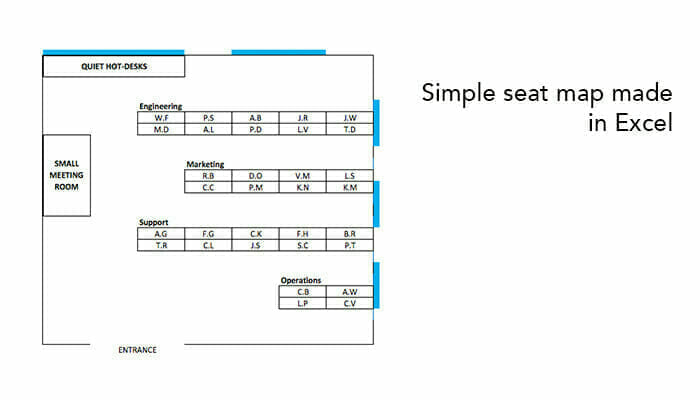Office
Seating Plan

How to Make an Office Seating Plan
Eden has lots of ways to help you work out how to make the best of your workspace – every business is different so we need your help to understand the business and from there we can come up with solutions for making the business work better in terms of layout, communications and department interactions. We have conducted major multi-week work surveys to establish the best balance of meeting rooms, permanent offices and hotdesking but for smaller offices we can spend a couple of hours working with you to find the right solution.
If you prefer to have a go yourself, here’s Hubble’s guide:

Are you moving to a new office or just planning to mix things up in your current one? Read our guide on how to make an office seating plan that works.
Creating a great seating plan isn’t just about creating a happy office, but a more productive one too. Just ask the researchers at Harvard Business School, who tell us that getting the seating right can add $1 million per annum to a company’s profit.
But don’t go rearranging the furniture just yet. For starters, the study found that this helped businesses of 2,000 workers, not 20. It’s perhaps most interesting to note that real improvements in productivity were made by placing ‘productive’ workers alongside ‘quality’ workers. The study certainly highlights the power of an effective seating plan and shows that symbiotic relationships can be created when you pair up people with opposite strengths.
Office seating plans – where to start?
So if you’re creating a seating plan for your new office, or think an office shake-up is in order, where do you start? Who gets the window seat and who gets to sit next to the CEO? Our 8 practical office seating plan tips are here to help.

Tip 1: Department proximity
First things first, take a practical look at your organisation. How many departments do you have, and how do they function alongside one another? It makes sense to seat departments together. While hot-desking and shared office spaces may encourage employees to sit wherever they feel like, sitting all of the IT team together and all of the accounts team together will help ensure easier communication and workflow.
Think about departments that often have to work hand in hand – the design and copywriting teams, or the accounts and HR teams, for example – and place them at close quarters. It’ll make it easier for them to confer on a daily basis.

Tip 2: Get personal
Once you’ve decided who needs to sit next to who, you can then move on to who wants to sit next to who.
Some employees will be introverts, some extroverts. Some are great at sparking conversation and ideas, others prefer peace and quiet to get their head down and work. This is where your seating plan starts to take on dinner plan dimensions. Who you sit with who has the power to make the evening a roaring success or a disaster.
Getting the interpersonal side of things right takes a deal of sensitivity, and often needs to be done on a micro rather than macro level. So don’t just talk to managers, talk to staff on the floor too. They’ll be able to give you real insight into who gets on well with who, as well as any potential issues to look out for.

Tip 3: Get practical
Now it’s time to look at the particular layout of your office space. Note the location of heating vents and air conditioning. Sitting right next to a blast of hot or freezing cold air all day isn’t pleasant for anyone. Also, take a look at the office lighting — lights can cause uncomfortable glare on computer screens. If it’s a new building that you’re unfamiliar with, get in touch with the building’s facilities staff to discuss any potential environmental issues.

Tip 4: A word on that window seat
Whether you’re in a new build or a converted warehouse, you’re a legal firm or a graphic design studio, one golden truth of office seating remains: everybody wants a window seat. Have a think about who you want to hand out these ‘superior’ seats to. They could go to more senior staff, or to workers who are non-client facing and tend to spend the most time sitting at their desks. If you’re operating a more relaxed seating system, you could choose to rotate teams so that everyone gets a window seat every once in a while.
Tip 5: How open do you like your open-plan?
Another key decision to make is where you want to position your executives. Some will be more comfortable in a private office, while others like to be part of the open-plan environment. It’s an instant leveller and can create a more relaxed relationship between executives and staff.

Tip 6: Involve your staff in the planning
It’s official, a happy workplace is a more productive workplace. A University of Warwick study found that a happy work environment makes people around 12 percent more productive. But what makes workers happy? A University of Exeter study says the surefire way to increase employee happiness to is to give them more control over the design and layout of their own workspace. So speak to your employees about their seating preferences – how much desk space do they need, for example, and would they prefer a standing desk? Give them a real say in where they sit and how they sit and everyone’s happier.

Tip 7: Communication and concentration – getting the balance right
Today’s office spaces are increasingly shared spaces. While this is great for creativity and communication, it can make it harder for workers to get the privacy or peace and quiet they sometimes need to get work done. When you’re considering how to make an office seating plan, be sure to include a space where employees can go to get some focused work done – a quiet area away from the desks or a separate room or area for phone calls.

Tip 8: Building the plan
Once you’ve decided, in-principle, where everyone’s going to sit it’s time to build the actual plan. Designing a floor plan – either by hand or using software – is essential as it gives you a bird’s-eye view of your space and allows you to play around with seating areas without having to actually shift around any furniture. Things to remember:
- First add the permanent structures including walls, windows, doorways and any obstructions.
- Include outdoor areas as well as the indoor rooms.
- Try placing office equipment, seating and decor as you initially envisioned to see how it actually looks on the page.
- Shift things around and experiment.
- Be prepared to revisit the plan once it’s been implemented – some logistical difficulties will only present themselves once employees actually trial the system!
Source: https://hubblehq.com/blog/how-to-make-an-office-seating-plan